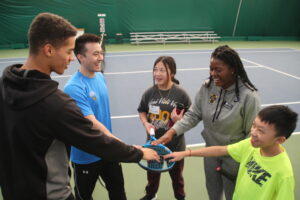Ok, I was Mr. Cranky Pants devil’s advocate two weeks ago on my first blog on visualizing. Or, rather, on visualization’s limits.
So, this week I will argue against my last week’s blog.
And you will see why living in my mind makes your life seem so much better.
Last week’s blog (click here to view) argued that no amount of visualization will do you any good if you do not put in the hard work, the daily grind, the commitment to all the little things no one sees behind the scenes that leads to successful results. I still stand by that.
BUT, wait. Without ‘seeing’ something in your mind before you do it, you cannot do it. “Seeing” comes before the work. It inspires us TO work.
I’ll give you examples from music, sports, and TLC’s Diversity, Equity, and Inclusion initiatives.
Music: When my wife Leandra and I first started our music career thirty years ago, we went to a sold-out show of another singer-songwriter at the Guthrie Theater (a 1200 seat theater in Minneapolis). I left the show, turned to Leandra and said, “We should play here this year.” She looked at me as if I had grown three heads. Then said, kindly, “No.” Then added, “Are you are nuts?”
Leandra was absolutely right (she almost always is), if we had tried it that year, we would have failed miserably. No one would have been there. (“BECAUSE WE DON’T HAVE AN AUDIENCE YET!” she would add). But part of me was right, too. I kept “seeing” it in my mind, and we set forth a plan of building our audience to sustain that venue. We worked and worked and were able to grow our audience over the years to the point we said we would give it a try. Therein started a ten-year run at the Guthrie. If we couldn’t “see” it, it would not have happened, unless it was a fluke.
Tennis: Let’s take something as simple (or difficult) as serving a tennis ball in a critical moment in a match. It is no secret to any tennis player that if one “sees” oneself double faulting, it often times comes true. And if one “sees” oneself serving well, it, too, often comes true. The power of “seeing” – visualizing – is profound. It is a motivator, both negative or positive, towards fear or confidence in what is possible. It sets us on a path. Not of certainty, but of possibility.
Life: TLC’s Diversity Training… When TLC started our intentional process of learning about and embracing the vast diversity that is present in the world and in tennis, we “saw” what was possible with the Three Crowns philosophy of Positive Attitude, Full Effort, and Good Sportsmanship and the impact that philosophy could have not just in tennis, or in our individual lives, but in examining societal inequities in our winter retreat camps with rural and urban kids coming together to learn. We had to “see” first the work that had to get done (diversifying staff, starting scholarship campaigns, learning first about our own biases before trying to address any of society’s systems, and learning from the stories of those who have traditionally been left out of the conversation). We did not know exactly “how” we would get there, only “that” we could get there. Now, though imperfect and still learning, TLC has a staff trained and committed to inclusion and giving voice to all. But it does not happen without a vision. It does not happen without “seeing”.
Let me stress again, though, that visualization – which is having that vision – cannot make something happen. It can only lead you in a direction.
I could visualize filling the Guthrie all I want, but if the Guthrie did not want to book us (there were many, many venues in the course of our career we “saw” getting into, and it did not happen), there is no way it will come true, no matter what anyone says or sees.
If I visualize a well-placed serve in a critical point, it doesn’t mean I’m actually going to succeed at it, only that I have a better chance of succeeding.
And I can visualize a more just world every moment, but if people are in place (from both sides of the aisle) who actively resist justice, it will not happen. Yet.
But it is guaranteed not to happen ever, if we stop “seeing” what is possible.
So what does that leave us with?
The Three Crowns. Positive Attitude. Full Effort. Good Sportsmanship. Steve Wilkinson, founder of TLC, was brilliant in creating this. It is so simple we are almost tempted to dismiss it. But these are the things we can always “see” and succeed at no matter the external circumstances of our lives and games. It works for changing tennis, individual lives, and societal systems. And it underscores the only thing we have control over from beginning to end. Our own actions. As we “see” that, then we can succeed, regardless of the outcome.
And so, I come back to my beginning conclusion of the first blog, after all. Mr. Cranky Pants loses again to the Three Crowns. Thankfully, I can “see” the victory in that.


Thank you Neil for another great message and reminder of the Three Crowns!
Thanks, Bruce 🙂
Neal, you are a excellent writer!!!